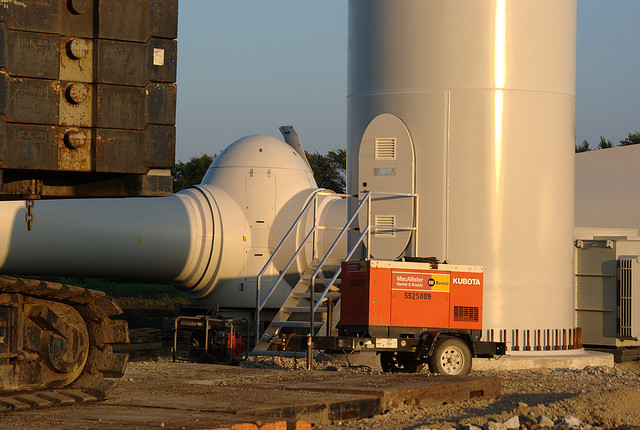Podcast: Play in new window | Download
Subscribe: RSS

A Texas-sized wind turbine under construction. This is what happens when industry embraces renewable energy. Whatever it is, it’s not sustainable. (Photo by vaxomatic/Flickr)
One of the core ideas of the book Brace for Impact and this website is expressed in the mantra: renewable is not sustainable if it’s industrial (actually, nothing is sustainable if it’s industrial, but for the moment let us focus on energy). If you want to follow the crash and burn of a large-scale demonstration of the principle, you need look no further than the Texas wind power miracle. Or debacle.
Industrial players ignored renewable energy for as long as they could, which, given their dominance of politics and the media was a very long time indeed. But the idea of getting electricity from an inexhaustible source would not go away when more and more people did the arithmetic on oil and realized that it was, in fact, going away. As that worry grew, and interest in sustainable energy grew along with it, industry turned to ridicule. (Who can forget Dick Cheney’s sneering comments, for example?)
When ridicule didn’t work, industry did what it has always done when forced onto the defensive: it co-opted the offense. Remember low-tar cigarettes? Low-fat food? Clean coal? Industry pivoted, and bulldozed into the renewable-energy bidness with multiple, multi-billion-dollar wind-”farm” and solar-”farm” projects. [See also: Solar “Farms” Keep us in the Dark]
(You gotta love the infatuation of the PR suits with the word “farm.” Hog pens and feed lots that consume the energy and put out the pollution of major cities are called “farms.” Or, better yet, “family farms.” So are arrays of behemoth, war-of-the-worlds wind turbines and thousand-acre arrays of solar concentrators. Maybe we should just give up and call New York City a person-farm.)
The main reason industry can’t do renewables sustainably is that it has only one basic business model: make the product in one location and distribute it to the consumer, always maximizing the size of the factory and the number of consumers to realize the economies of scale. So how is that working out for them in Texas?
Texas has more wind-power generating capacity than any other state. But do not attribute this to a Texas miracle of self-reliance, disdain for government and low taxes. There are two reasons that all those turbines got stuck up in the air: a 1999 state law requiring electric utilities to buy wind power; and enormous federal subsidies. Without those two things, the only thing in the wind in Texas today would be barbed wire.
And even with its revenues guaranteed and its financing provided by a grateful state and nation, the Texas wind industry is driving consumer electricity costs up, because no one thought to subsidize the building of the enormous transmission lines required to get the wind power for the “farm” to the consumers. According to OilPrice.com, what was supposed to be a less-than $5 billion project is now an almost $7 billion project and by the time it’s complete, in 2013 or 2020 or 25, who knows?
(Here’s why government should NOT be run more like business: in making the initial estimates of the cost of the transmission lines, the financial geniuses assumed that the lines would run straight like the crow flies, not along roads or property lines or around anything. And they left out the costs of financing.)
The impact of the overrun so far is calculated to be the equivalent of $800 for every household in Texas, or a surcharge of $5 per month per ratepayer. That’s just for the overrun, which is not complete yet.
Is there another way to do this? Of course there is. A slight adaptation of the traditional Texas windmill, which used to pump water for just about every ranch, could provide the electricity for just about every rural home. Individual solar arrays and wind turbines could power a real Texas miracle, with no huge transmission lines needed, no “farms” growing skyscraper wind turbines.
But that would take real initiative, not to mention gumption, from people who do not rely on government subsidies to pay for what they do or on government regulation to provide them with a payoff for what they do. So forget Texas. It would take a miracle.
-0-